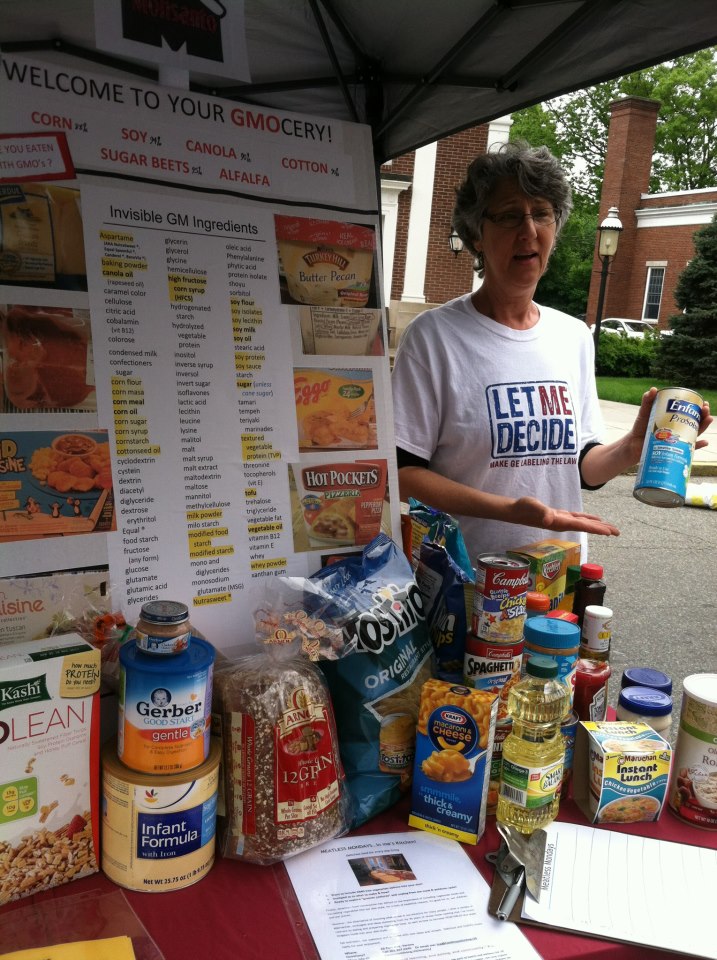We are concerned about GMOs in our diet. Can you tell me which foods I should avoid to keep GMOs out of our pantry and off our plates?”
The five foods you most need to concern yourself with if you want to steer clear of GMO foods are :
- Soy and all its derivatives: (flour, oil, lecithin, protein, isolate and isoflavone)
- Corn and all its derivatives: (flour, meal, starch, high fructose corn syrup, dextrose, glucose)
- Sugar derived from beets (which read on labels as sugar, or pure sugar. Instead look for “cane sugar”, which comes from sugar cane, and is not GMO-modified.)
- Canola oil (Also called rapeseed oil, sometimes combined with corn and/or soy oil and called vegetable oil)
- Cottonseed oil

These are the top 5 GMO foods, and once you start reading ingredient labels, you will find them, usually listed as multiple ingredients, in nearly 80% of all mainstream processed, frozen, baked and packaged foods. They are ubiquitous within our food system, from cereals to breads, soups to frozen dinners, snacks and ice cream, even some infant formulas.
The best way to ensure you aren’t eating GMO foods is to purchase packaged/processed foods that have been Non-GMO Project-certified. This is the current gold standard of labeling (with a maximum Action Threshold of 0.9% possibly being GMOs, which is in alignment with laws in the European Union).
USDA Certified Organic is the other label to look for. Organic certification does not allow the use of any genetically engineered product or ingredient in the growing of crops or raising of livestock. In the case of a processed food with multiple product ingredients, the USDA organic seal verifies that the product has 95% or more certified organic content – genetically engineered products are not allowed.
So now you know which labels to look for when buying packaged foods. But how do you really go about making the switch to GMO-free, and what should you get rid of first? That depends upon your time, access to organic products and animal foods, and your wallet.

Here are some further guidelines:
- To avoid GMO ingredients, as often as possible, eat REAL foods that are whole and unprocessed. Shifting your diet towards whole foods you prepare yourself is healthiest, period. Practically always, processed and packaged foods that have multiple ingredients also contain and one or more of the 5 major GMO foods named above. They also likely contain artificial colors, flavorings and long-named chemical additives, so you’ll be doing yourself extra benefit when you reduce GMOs from your diet.
- Simple organic whole foods make great snacks and lunches. A hard-boiled egg, piece of good cheese or handful of nuts with a carrot, yogurt and piece of fruit all can satisfy and take no cooking.
- Download the Non-GMO Shopping Guide and use it when you shop. It can help you find alternatives to some of the staple products you are used to. Ask the store manager if you don’t see a product you want. That’s how change happens. Don’t sweat the small stuff, like corn starch in a product. But DO consider changing your daily breads, breakfast cereal, eggs, deli meats, and yogurt to Non-GMO Project or USDA Organic certified.
- Look to your diet and see where the most GMO ingredients are. Realize, unless you purchase organic beef, chicken, turkey, or pork, the animals or dairy you ingest are fed GMO alfalfa, corn, and/or soy. This is most likely the case for farmed fish as well. If you eat multiple meals per week with animal foods, and you have access to organic animal products, I highly recommend you make the switch. You can also eat less of the organic animal foods, to compensate for their cost, which is far greater but worth every cent. Consider adding healthy legumes like lentils, chick peas and black beans into your diet. Organic canned beans are a fraction of the cost compared to animal products, and they are so healthy.
- Eating out is the most problematic because you have the least control and information. You can assume that restaurants use GMO foods unless they state otherwise. This means vegetable oils, sauces, meats, chicken, eggs, breads, baked goods, desserts, you name it, are likely to contain GMO ingredients. Order soy-free vegetarian or wild caught fish unless you know the animal foods are organic, and then of course, it will be more expensive. It’s a good idea to ask the manager, thus bringing your concerns as a patron to their attention. Mediterranean restaurants may be the best bet, as they use olive oil in their cuisine. By the way, this eating out list includes all institutional food; hospitals, schools, business cafeterias, etc. When you eat out, you’ll do the best you can by ordering vegetarian.
- Don’t get overwhelmed. The ubiquity of GMOs feels like a daunting assault when you first realize it, especially if you’re not already purchasing a dominance of organic products. Some change is better than no change at all, and I personally rank animal products highest on my list because the GMO-fed animals (which dominate) are also inhumanely raised compared with organic pasture-raised animals (another very important topic). Give yourself time to grow into new foods and new ways of eating. Unless you’re a gazillionaire with a private chef or live in a bubble, it’s nearly impossible to eliminate all GMOs. Any and all change is positive and beneficial. The more WE purchase and demand non-GMO foods, the more WE will drive the market to respond.
Have a question about good food? Trying to avoid “not good” food? Ask Ina! Send your questions about healthy eating and good food to Ask Ina.
About Ina Denburg
 Ina is a Lifestyle Coach and Wellness Educator who has lived and worked on the path of health and wellness for 30 years. She is passionate about wellness, her practice continuumLiving, is devoted to helping others discover, define and live it for themselves – at home, at work, and in school.
Ina is a Lifestyle Coach and Wellness Educator who has lived and worked on the path of health and wellness for 30 years. She is passionate about wellness, her practice continuumLiving, is devoted to helping others discover, define and live it for themselves – at home, at work, and in school.
GMO-Free Kitchen – a service Ina provides for individuals or groups. All consumer aspects from understanding to eliminating GMO foods, from cleaning them out of your pantry to shopping and replacing with upgraded food items, to learning how to cook delicious GMO-free meals.
Read more about Ina’s background and experience here.


Hi Shelly –
Thank you for your comments & keen eyes.The Kashi box I chose is one that has soy in it, and since the soy is NOT organic certified, or Non GMO Project certified,it must be assumed to be GMO. It was also in the news that Kashi’s soy tested as GMO modified back in October of 2011.
BTW – Kashi, (a subsidiary of Kellogs)spent nearly $800,000 fighting Proposition 37, the California ballot initiative for GMO labeling. Kashi was part of a $46 million campaign to silence the consumer’s right to know.
The box of 365 Oats, however, was included in the display to demonstrate the Organic seal certification to look for when purchasing products. (Oats are not a GMO food) My GMOcery display includes examples of “the good, the bad & the ugly”.
I eagerly read your article as I’ve been trying to eliminate GMO’s since finding out how damaging they are to our bodies as well as our ecosystem. I’m so appreciative of the work you’ve been doing in getting the word out. The display on view above is a great gear turner (and probably easy to take on the road, lots of preservatives!) I’m surprised though, to see two items in the photo that I would not have thought belong among the nefarious products: Kashi GOLEAN cereal and Whole Foods 365 ORGANIC Rolled Oats. What’s up with that?!